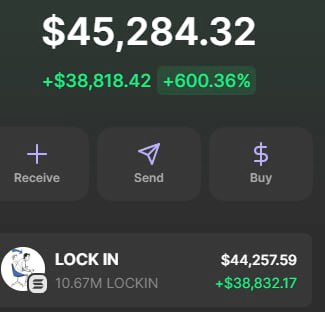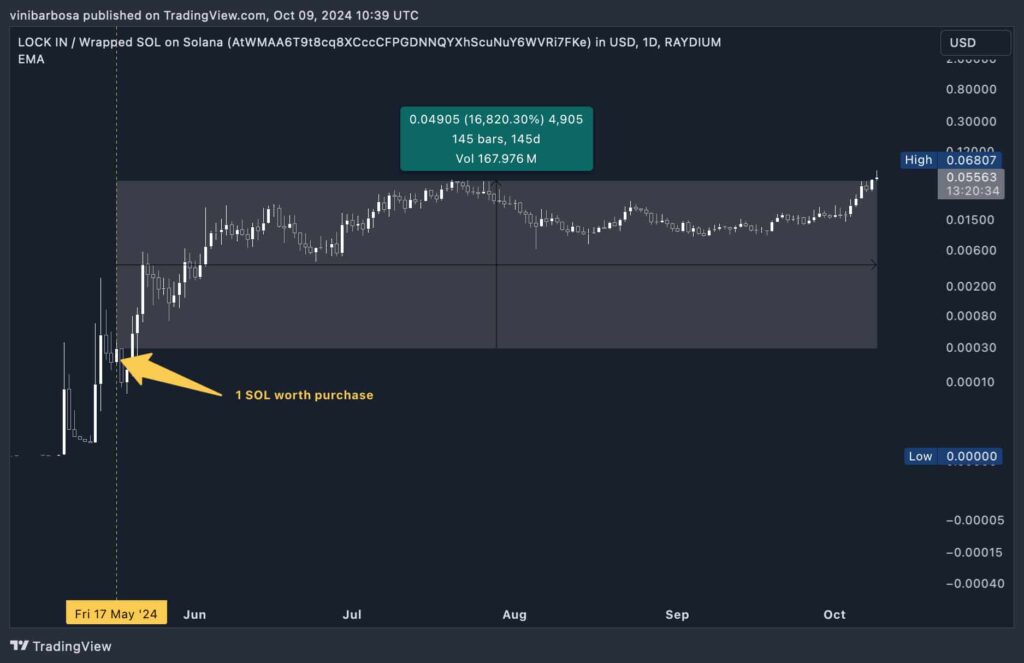This trader turned $150 into $500,000 in 130 days of ‘locking in’ 
![]() Cryptocurrency Oct 9, 2024 Share
Cryptocurrency Oct 9, 2024 Share
A cryptocurrency trader has turned a 1 SOL initial purchase, worth around $150, into nearly $500,000 with $lockin. The trader, who goes by Salazar on X, has been documenting the journey and aims at far higher prices.
On October 8, Salazar shared a “Lock in” wallet balance of $498,286.50, up 15.77% in 24 hours. In the post documented as “Day 130,” he says he feels disappointed by his friends who could have achieved the same results but did not.
Salazar stated that the wallet balance will be “rapid repricing” to $200 million once $lockin breaks its all-time high (ATH). According to previous posts, this is his ultimate target when he plans to start selling and realizing profits.
Picks for you
Fuse unveils Charge, the first Web3 merchant bank 5 seconds ago Bitcoin price prediction after FOMC minutes are released 35 mins ago BlackRock's top 2 crypto picks: Are they living up to the hype? 2 hours ago ChatGPT-4o predicts Gold price for end of 2024 3 hours ago
Day 130
This is almost equal with thread ath, which was slightly above $500k. This time instead of euphoria I feel disappointed. Disappointed that my friends didn't make it back with me or believe. When $lockin breaks prior ath I expect a quick and rapid repricing to $200m. https://t.co/oVes3AStwI pic.twitter.com/LAgMXV0otf
— Salazar (lock/in) (@ctlarp) October 8, 2024
Salazar’s 1 SOL to $200 million locked-in bet
Notably, the trader has been recurrently sharing these balances with a daily insight into the experience since May 22. At that time, Salazar’s wallet showed a $45,284 balance while claiming he had $100 in his bank account.
From May 21 to May 22, $lockin surged by 600%, rewarding the traders’ unrealized profits with an increase of over $38,818. The goal, as stated in this post, was to turn 1 SOL into 5000 by “simply locking in.”
“People telling me to sell because I have $100 in my irl account and this coin makes up 100% of my portfolio You know what I have to say to them? Grow up. Lock in. I will be the first person to turn 1 sol to 5000 by simply locking in. It’s a mindset, not a meme.”
– Salazar on May 22
 Salazar’s Lock In $lockin wallet balance on May 22. Source: Salazar / Finbold
Salazar’s Lock In $lockin wallet balance on May 22. Source: Salazar / Finbold
The ‘Lock In’ mindset and trading strategy
Diving into Salazar’s older posts, we found multiple explanations of his thesis, which is, so far, paying off. Essentially, the $lockin trader explains that “lock in” is the keyphrase of this bull cycle, repeated by many influential people.
This, in his belief, creates a mindset of cryptocurrency investors and traders to lock in their investments and avoid settling for low gains or even losses, patiently looking for higher gains backed by a solid thesis.
However, the trader started the “lock in” challenge with a target of $50 million, already changing it motivated by strong emotions. Experienced traders usually warn of this behavior being caused by overconfidence and euphoria, setting an emotional trap for the investor.
Moreover, $lockin is a significantly low liquidity token in the Solana ecosystem, which may challenge Salazar when trying to sell. Additionally, Solana is known for the massive number of failed transactions and MEV abuse that creates difficulties while exchanging tokens.
$lockin price analysis
As of this writing, $lockin is trading at 0.0556 SOL per token, up 16,820% since May 17, when Salazar allegedly made the initial investiment with 1 SOL and “locked in” for the gains.

LOCKIN/SOL daily price chart on Raydium. Source: TradingView / Finbold
Meme coin traders and the ‘Greater Fool Theory’
Cryptocurrencies are inherently volatile and present considerable risks for traders, investors, and users, even with solid and usable projects.
However, trading meme coins adds another layer of risks, especially liquidity-related. Losses can be even more aggressive than the unrealized gains were, as Finbold reported.
This asset class has characteristics that resemble financial bubbles, which can result in liquidity death spirals. The “Greater Fool Theory” explains the dynamics seen on meme coins. They are speculative tokens moved primarily by social hype and buzz without a clear organic demand.
Traders buy the token with the expectation that a “greater fool” will pay a higher price in the future. In conclusion, the scheme fades away once there are no “greater fools” to continue fueling the price up, often facing liquidity issues and death spirals.